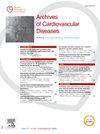使用多参数评估的机器学习评分用于心脏淀粉样变性的死亡预测
IF 2.2
3区 医学
Q2 CARDIAC & CARDIOVASCULAR SYSTEMS
引用次数: 0
摘要
背景:心脏淀粉样变性(CA)是一种预后差且发病率增高的严重疾病。轻链(AL)和转甲状腺素(ATTR)淀粉样变性预后分层的现有评分系统是基于有限的生物学参数。允许处理更多数量和更复杂的变量,机器学习(ML)可以改善预后评估。目的探讨基于临床、生物学和影像学特征的监督ML算法预测CA患者全因死亡率的可行性和准确性。方法数据收集自法国心脏淀粉样变性转诊中心数据库(Hôpital Henri-Mondor, crteil),包括2010 - 2023年野生型ATTR (n = 777)、遗传性ATTR (n = 304)和AL (n = 432) CA患者1513例(图1)。基于综合临床、生物学和影像学特征,我们评估了几种监督式机器学习算法(Random Forest、Random Forest Ranger、XGBoost和LASSO)预测全因死亡率的准确性,并与传统逻辑回归进行了比较。结果纳入的1513例CA中,636例(42%)在中位随访1.5年期间死亡(IQR: 0.5 ~ 3.1)。与logistic回归相比,使用XGBoost的ML评分在预测全因死亡率方面表现出更高的曲线下面积(AUC 0.76 vs 0.67, P <;0.001;图2)。在ATTR队列中,使用Random Forest ranger的ML评分比使用logistic回归的ML评分表现更好(AUC ML评分0.77比使用logistic回归的0.72,P = 0.008)。然而,在AL队列中,ML评分与增量预后价值无关。结论与传统方法相比,结合临床、生物学和影像学参数的ml模型预测CA患者全因死亡率的准确率最高。本文章由计算机程序翻译,如有差异,请以英文原文为准。
Machine learning score using multiparametric assessment for death prediction in cardiac amyloidosis
Background
Cardiac amyloidosis (CA) is a severe disease with poor prognosis and increasing incidence. Available scoring systems for prognostic stratification in light chain (AL) and transthyretin (ATTR) amyloidosis are based on limited biological parameters. Allowing process of a greater number and complexity of variables, machine learning (ML) could improve prognostic assessment.
Objectives
To investigate the feasibility and accuracy of supervised ML algorithms using clinical, biological and imaging features to predict all-cause mortality in CA patients.
Methods
Data were collected from the French Referral Center for Cardiac Amyloidosis database (Hôpital Henri-Mondor, Créteil), including 1513 patients with wild type ATTR (n = 777), hereditary ATTR (n = 304) and AL (n = 432) CA between 2010 and 2023 (Fig. 1). Based on comprehensive clinical, biological and imaging features, we assessed accuracy of several supervised ML algorithms (Random Forest, Random Forest Ranger, XGBoost and LASSO) to predict all-cause mortality and compared with traditional logistic regression.
Results
Among 1513 CA included, 636 (42%) died during a median follow-up of 1.5 years (IQR: 0.5–3.1). ML score using XGBoost exhibited a higher area under the curve compared with logistic regression for prediction of all-cause mortality (AUC 0.76 vs 0.67, P < 0.001; Fig. 2). In ATTR cohort, ML score using Random Forest ranger evidenced better performance compared with logistic regression (AUC ML score 0.77 vs 0.72 with logistic regression, P = 0.008). However, in AL cohort, ML scores were not associated with an incremental prognostic value.
Conclusion
A ML-model including clinical, biological and imaging parameters showed the best accuracy to predict all-cause mortality in CA patients compared with any traditional methods.
求助全文
通过发布文献求助,成功后即可免费获取论文全文。
去求助
来源期刊

Archives of Cardiovascular Diseases
医学-心血管系统
CiteScore
4.40
自引率
6.70%
发文量
87
审稿时长
34 days
期刊介绍:
The Journal publishes original peer-reviewed clinical and research articles, epidemiological studies, new methodological clinical approaches, review articles and editorials. Topics covered include coronary artery and valve diseases, interventional and pediatric cardiology, cardiovascular surgery, cardiomyopathy and heart failure, arrhythmias and stimulation, cardiovascular imaging, vascular medicine and hypertension, epidemiology and risk factors, and large multicenter studies. Archives of Cardiovascular Diseases also publishes abstracts of papers presented at the annual sessions of the Journées Européennes de la Société Française de Cardiologie and the guidelines edited by the French Society of Cardiology.
 求助内容:
求助内容: 应助结果提醒方式:
应助结果提醒方式:


